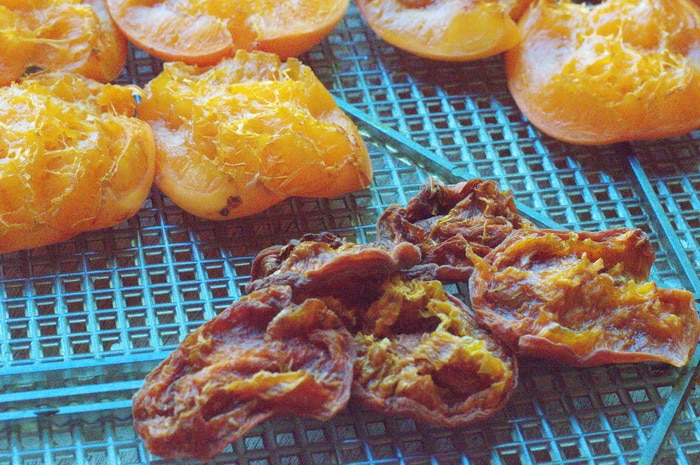Dried apricots are a great way to preserve the summer apricot bounty for winter use. With a dehydrator, or your oven, you can quickly prep and dry your surplus, ripe apricots. Dried apricots often have better flavor and texture than fresh, so if you don’t like fresh you might like dried.
Growing up, I hated fresh apricots. They were mealy, bland, and unappetizing as a fresh fruit. They were sort of okay in cobbler, or crumble, but peaches and cherries were always better. Then, one Christmas I had white chocolate covered dried apricots and they were amazing! Dried apricots have a much richer flavor and tone than their fresh counterparts, and none of the mealy texture either.

Once dehydrated it is recommended to only store apricots for 8 months to a year. However, I have had home dried apricots that tasted just as good as fresh dried ones after 3 years. As with any dehydrated fruit, make sure to store them in sealed zippered plastic bags in closed containers, or in glass jars. Storing in glass, or the double storage method with zippered bags, helps keep moisture away from the fruit and helps preserve freshness longer. I find glass can take up a lot of space, though for damp climates it is better than zippered plastic bags.
Apricots are, possibly, the easiest stone fruit to prepare for dehydration. Even the largest apricots do not need to be cut into pieces, if you are using a standard food dehydrator.
Home dried apricots will be dryer and more leathery than commercially available dried apricots. The commercially available ones are dried whole, with the skin on. Homemade are cut in half and then dried with the skin on, and retain less moisture. As a result, home dried apricots will seem dryer, but the flavor is very similar.
How to Make Dried Apricots:
Start with sorting the apricots, and removing those that are still over green. While it is sometimes recommended to discard bruised or over-ripe apricots, they ares till suitable for drying as long as there is no mold, and they are not fermented. You can also sort into sizes, if you have larger and smaller apricots. Keep like-sized apricots on the same tray to make for even drying.
You should be able to fit about a pound of fruit per dehydrator tray, depending on the size of your dehydrator. If you have a 15 tray dehydrator, you can probably fit 10-15 pounds of fruit. Calculate your fruit need based on your personal dehydrator’s capacity. You can use an oven for dehydrating apricots, it is just not as energy or time efficient.


Dried Apricots
Description
Easy and efficient homemade dried apricots.
Ingredients
- 5–15 pounds of apricots
- Optional: 1/4 -1/2 cup lemon juice
Instructions
- Wash all apricots with a light solution of dish detergent and cool water. Rinse thoroughly. This will remove any pesticide residue from commercially grown apricots. If your apricots are home grown and not sprayed, a water rinse can be sufficient.
- Any badly damaged area on the apricot should be cut off with a knife, same with mild mold spots. You can preserve the rest of the apricot.
- Slice the apricot along the seam and split in half with your fingers. If the apricots are ripe enough, you can do this with just your thumbs and no knife.
- Remove the pit, and set aside to wash for projects, or compost.
- Turn the apricot inside out by pressing on the skin-side center of the apricot. This makes sure the flesh does not seal, and ensures even drying. Turning the apricot inside out is vitally important if you are working with larger or jumbo sized apricots.
- Evenly space on dehydrator trays.
- Spritz with lemon juice to prevent browning. I do not find that apricots oxidize, and normally do not use a lemon spritz.
- Apricots can barely touch on their edges, but shouldn’t actually overlap. As they dry the edges that barely touch will shrink away from each other and not impact drying time or airflow.
- Dehydrate between 115F and 125F for 12 hours. Or, you can start them at 135F for 2 hours, and then lower the temperature to 125 for the remaining time.
- Check to see if the apricots are leathery, and make sure the flesh does not slide against itself when pinched between two fingers. If the flesh slides when pinched, they are not dry enough and should go back in for another few hours. Let cool completely and pack into glass jars, or plastic zippered bags, for storage.
Ingredients:
5-15 pounds of apricots
Optional: lemon juice
Directions:
Wash all apricots with a light solution of dish detergent and cool water. Rinse thoroughly. This will remove any pesticide residue from commercially grown apricots. If your apricots are home grown and not sprayed, a water rinse can be sufficient.
Any badly damaged area on the apricot should be cut off with a knife, same with mild mold spots. You can preserve the rest of the apricot.
Slice the apricot along the seam and split in half with your fingers. If the apricots are ripe enough, you can do this with just your thumbs and no knife.
Remove the pit, and set aside to wash for projects, or compost.
Turn the apricot inside out by pressing on the skin-side center of the apricot. This makes sure the flesh does not seal, and ensures even drying. Turning the apricot inside out is vitally important if you are working with larger or jumbo sized apricots.
Evenly space on dehydrator trays.
Spritz with lemon juice to prevent browning. I do not find that apricots oxidize, and normally do not use a lemon spritz.
Apricots can barely touch on their edges, but shouldn’t actually overlap. As they dry the edges that barely touch will shrink away from each other and not impact drying time or airflow.
Dehydrate between 115F and 125F for 12 hours. Or, you can start them at 135F for 2 hours, and then lower the temperature to 125 for the remaining time.

Check to see if the apricots are leathery, and make sure the flesh does not slide against itself when pinched between two fingers. If the flesh slides when pinched, they are not dry enough and should go back in for another few hours. Let cool completely and pack into glass jars, or plastic zippered bags, for storage.
Your Turn:
Dehydration works well to preserve other types of fruits and vegetables. You can make amazing zucchini chips, jerky, and even spicy kale chips with just a handful of ingredients and a few minutes, or hours, of hands on time. Other fruit options for dehydration include cherries, grapes, apples, bananas, strawberries, peaches, pears, and more.
What is your favorite use for dried apricots? or favorite preserving method for fresh apricots? Leave a comment, I would love to hear from you.



Leave a Reply